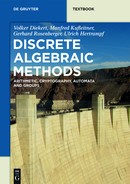0%
42Chapters
0-1Hours read
0kTotal Words
Table of Contents
- Cover
- Title Page
- Copyright Page
- Preface
- Contents
- 1 Algebraic structures
- 2 Cryptography
- 2.1 Symmetric encryption methods
- 2.2 Monoalphabetic cipher
- 2.3 Polyalphabetic cipher
- 2.4 Frequency analysis and coincidence index
- 2.5 Perfect security and the Vernam one-time pad
- 2.6 Asymmetric encryption methods
- 2.7 RSA cryptosystem
- 2.8 Rabin cryptosystem
- 2.9 Diffie–Hellman key exchange
- 2.11 Cryptographic hash functions
- 2.12 Digital signatures
- 2.13 Secret sharing
- 2.14 Digital commitment
- 2.15 Shamir’s attack on the Merkle–Hellman cryptosystem
- Exercises
- Summary
- 3 Number theoretic algorithms
- 3.1 Runtime analysis of algorithms
- 3.2 Fast exponentiation
- 3.3 Binary GCD
- 3.4 Probabilistic recognition of primes
- 3.5 Extracting roots in finite fields
- 3.6 Integer factorization
- 3.7 Discrete logarithm
- 3.8 Multiplication and division
- 3.9 Discrete fourier transform
- 3.10 Primitive roots of unity
- 3.11 Schönhage–Strassen integer multiplication
- Exercises
- Summary
- 4 Polynomial time primality test
- 5 Elliptic curves
- 6 Combinatorics on words
- 7 Automata
- 8 Discrete infinite groups
- 8.1 Classical algorithmic problems
- 8.2 Residually finite monoids
- 8.3 Presentations
- 8.4 Rewriting systems
- 8.5 Solving the word problem in finitely presented monoids
- 8.6 Free partially commutative monoids and groups
- 8.7 Semidirect products
- 8.8 Amalgamated products and HNN extensions
- 8.9 Rational sets and Benois’ theorem
- 8.10 Free groups
- 8.11 The automorphism group of free groups
- 8.12 The special linear group SL(2, ℤ)
- Exercises
- Summary
- Solutions to exercises
- Bibliography
- Index
- Footnotes
